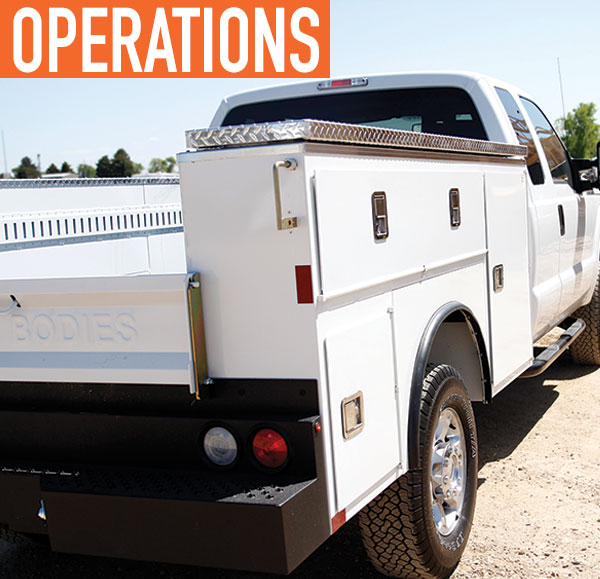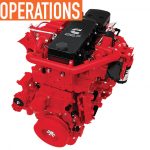Until recently, purchasing an aluminum utility or service body for a work truck was often dismissed due to perceived price point, strength concerns, and repair costs.
Aluminum has been used as a manufacturing material for decades in a number of industries, including aeronautics and agricultural products. Knowing NASA trusts the material, I would say it’s hard not to consider it. With the recent push of Ford Motor Company featuring aluminum as their primary body type going forward, many consumers are quickly changing their thought process when it comes to purchasing an aluminum work truck body.
LONG-LASTING SOLUTION
Since making its way to the work truck industry, the previous concerns of using aluminum are being squashed. Aluminum has proven its strength and durability within the industry and body manufacturers are now comfortable quoting and building it in almost all instances. With aluminum’s corrosive and rust preventive properties, it is easy to dismiss the question of how long the body will last, leading body manufacturers to throw in longer warranties for rust through/perforation—often reaching 10 years with minimum material maintenance. This nearly doubles the length of a standard, steel body rust warranty.
When manufacturing out of aluminum, you instantly see weight savings from the steel version of the same body. When building with aluminum, a thicker material is usually required, but the end result still ends up being 30 to 40 percent or more in weight savings in some applications. These savings allow you to increase your payload while maintaining strength. For the ultimate in overall payload, combine an aluminum truck body with a new Ford Super Duty aluminum body and see your service truck become a gear-toting machine.
The capability of increased payload in an aluminum body means service techs and engineers can haul more than a steel bodied transport, while still weighing roughly the same. By hauling in an aluminum body the equivalent of what you would in a steel body, you can see a boost in fuel efficiency. No matter which you choose, aluminum’s weight savings can result in better fuel efficiency and overall savings on fuel costs.
One of the most debated issues when using aluminum materials is repair cost. As aluminum becomes more widely used in other industries, finding an aluminum welder for repairs is not as difficult as it once was. Insurance companies have been finding them for years in the marine industry. More available repair shops providing aluminum services create more competitive repair pricing. Another option is the purchase of a component body, which is a modular configuration allowing you to only have to order certain parts of the body when they need to be replaced. This can often prove to be more cost effective than the repair. Ford and other auto manufacturers have been using a similar system for years.
With a longer warranty, increased payload, and possible increased fuel efficiency, can you really afford not to consider aluminum?

Quotes are free. Don’t settle for steel when aluminum is an option. Ask for a quote in both material types and put them side-by-side, allowing you to make an informed decision about your next truck body or accessory.
STEEL MAINTENANCE
Steel is a staple material in manufacturing. With its rigid properties, it is able to withstand almost any abuse thrown at it…except moisture.
Because of this, most body materials used today are galvannealed steel. Galvanneal is a coating and annealing process that applies a zinc exterior coating to the steel, increasing corrosion resistance. When you weld, cut, or penetrate the coating with a rivet, however, it exposes those areas to the base steel material, creating a location for the body to start rusting. These areas often need to be examined, cleaned, and touched up with paint in order to prevent rust and corrosion. These maintenance tasks are often ignored, which results in a deteriorated body structure. Adding to that, exterior rust is usually unappealing to the eye.
Manufacturers have worked hard to come up with ways to extend the steel body’s life span and they have succeeded with various paint coatings. Due to the harsh environments these products are exposed to, however, the coating layer is often compromised, which exposes the steel. Zinc-rich primer (ZRP) is the perfect solution to overcome these deficiencies. If the coating is penetrated, the ZRP will minimize rust and keep corrosion from spreading beneath the finish-coated surface. The sacrificial properties of the zinc that make up this primer create a wall so that when the primer is penetrated, and rust starts, it is not able to spread throughout the body. Essentially, ZRP stops the rust where it starts.
In addition to adding protective coatings to the steel bodies, some manufacturers are beginning to use thinner steel materials in order to cut down on body weight. While using a thinner material may result in less weight, it also greatly impacts the strength and durability of the end product.

Aluminum bodies resist rust and can hold their own at harsh worksites.
DECISION MAKING
When it comes to materials for various body accessories, steel is often the preferred material due to its rigid properties. Material hooks, for instance, when made from aluminum, will bend when loaded beyond specified capacity. Steel material hooks do not bend, but will shear off when loaded beyond specified capacity. In these cases, steel’s capacity makes it a better option than aluminum. Other locations where steel is beneficial include shelving and drawer units. Again, because it’s holding materials while spanning a space, it will have a much greater carrying capacity.
Aluminum thrives in exterior accessories, like top boxes, ladder racks, and baskets. Using aluminum means you can elect to use the products un-painted, saving money in the manufacturing process. With clean aluminum, the product still looks good and because of the natural rust and corrosion resistance, the coating is unnecessary to protect against the elements. For cosmetic appearance, aluminum should be given an acid bath every few years to clean up the exterior, but this is not a necessary maintenance task.
Aluminum treadbrite toolboxes have been used in pickup beds for decades, while aluminum top boxes for truck bodies can say the same of their longevity. Recommended for its lighter weight, rust resistance, and quicker manufacture time—since aluminum treadbrite doesn’t need the coating that steel does—it’s hard to see the downside to an aluminum body.
ABOUT THE AUTHOR:
Mac Blais is the marketing manager for Dakota Bodies. Find out more about available truck bodies from Dakota Bodies, visit www.dakotabodies.com.
_______________________________________________________________________
MODERN WORKTRUCK SOLUTIONS: JULY 2016 ISSUE
Did you enjoy this article?
Subscribe to the FREE Digital Edition of Modern WorkTruck Solutions magazine.
![]()




